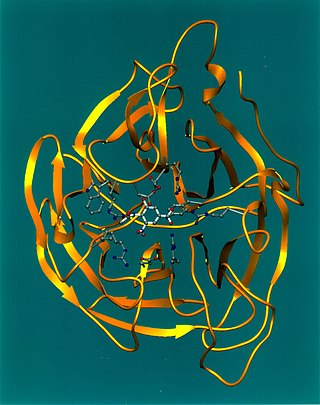
Mannans are polymers containing the sugar mannose as a principal component. They are a type of polysaccharide found in hemicellulose, a major source of biomass found in higher plants such as softwoods. These polymers also typically contain two other sugars, galactose and glucose. They are often branched.

Cellulase is any of several enzymes produced chiefly by fungi, bacteria, and protozoans that catalyze cellulolysis, the decomposition of cellulose and of some related polysaccharides:

Maltase is one type of alpha-glucosidase enzymes located in the brush border of the small intestine. This enzyme catalyzes the hydrolysis of disaccharide maltose into two simple sugars of glucose. Maltase is found in plants, bacteria, yeast, humans, and other vertebrates. It is thought to be synthesized by cells of the mucous membrane lining the intestinal wall.

Acarbose (INN) is an anti-diabetic drug used to treat diabetes mellitus type 2 and, in some countries, prediabetes. It is a generic sold in Europe and China as Glucobay, in North America as Precose, and in Canada as Prandase.

Exo-α-sialidase is a glycoside hydrolase that cleaves the glycosidic linkages of neuraminic acids:

β-Amylase is an enzyme with the systematic name 4-α-D-glucan maltohydrolase. It catalyses the following reaction:
Alpha-glucosidase inhibitors (AGIs) are oral anti-diabetic drugs used for diabetes mellitus type 2 that work by preventing the digestion of carbohydrates. Carbohydrates are normally converted into simple sugars (monosaccharides) by alpha-glucosidase enzymes present on cells lining the intestine, enabling monosaccharides to be absorbed through the intestine. Hence, alpha-glucosidase inhibitors reduce the impact of dietary carbohydrates on blood sugar.

α-Glucosidase (EC 3.2.1.20, is a glucosidase located in the brush border of the small intestine that acts upon α bonds:

α-Amylase is an enzyme that hydrolyses α bonds of large, α-linked polysaccharides, such as starch and glycogen, yielding shorter chains thereof, dextrins, and maltose, through the following biochemical process:
The enzyme mannosyl-glycoprotein endo-β-N-acetylglucosaminidase (endoglycosidase H) (EC 3.2.1.96) has systematic name glycopeptide-D-mannosyl-N4-(N-acetyl-D-glucosaminyl)2-asparagine 1,4-N-acetyl-β-glucosaminohydrolase. It is a highly specific endoglycosidase which cleaves asparagine-linked mannose rich oligosaccharides, but not highly processed complex oligosaccharides from glycoproteins. It is used for research purposes to deglycosylate glycoproteins and to monitor intracellular protein trafficking through the secretory pathway.
A chemical glycosylation reaction involves the coupling of a glycosyl donor, to a glycosyl acceptor forming a glycoside. If both the donor and acceptor are sugars, then the product is an oligosaccharide. The reaction requires activation with a suitable activating reagent. The reactions often result in a mixture of products due to the creation of a new stereogenic centre at the anomeric position of the glycosyl donor. The formation of a glycosidic linkage allows for the synthesis of complex polysaccharides which may play important roles in biological processes and pathogenesis and therefore having synthetic analogs of these molecules allows for further studies with respect to their biological importance.

Glucansucrase is an enzyme in the glycoside hydrolase family GH70 used by lactic acid bacteria to split sucrose and use resulting glucose molecules to build long, sticky biofilm chains. These extracellular homopolysaccharides are called α-glucan polymers.

Acarviosin is a sugar composed of cyclohexitol linked to a 4-amino-4,6-dideoxy-D-glucopyranose. Acarviosin is part of the potent α-amylase inhibitor acarbose and its derivatives. Acarviosin is a product of the degradation of acarbose by gut microbiota, the glycoside hydrolase from gut bacteria Lactobacillus plantarum is able to hydrolyze acarbose to maltose and acarviosin. The nitrogen atom binds to α-amylase more tightly than the natural substrate making it more potent than other inhibitors. Several other acarviosin-containing α-amylase inhibitors have been found in microbes including isovalertatins and butytatins from Streptomyces luteogriseus and longer oligosaccharides from Streptomyces coelicoflavus.
Mannosyl-oligosaccharide 1,2-α-mannosidase (EC 3.2.1.113, mannosidase 1A, mannosidase 1B, 1,2-α-mannosidase, exo-α-1,2-mannanase, mannose-9 processing α-mannosidase, glycoprotein processing mannosidase I, mannosidase I, Man9-mannosidase, ManI, 1,2-α-mannosyl-oligosaccharide α-D-mannohydrolase) is an enzyme with systematic name 2-α-mannosyl-oligosaccharide α-D-mannohydrolase. It catalyses the hydrolysis of the terminal (1→2)-linked α-D-mannose residues in the oligo-mannose oligosaccharide Man9(GlcNAc)2.
Mannosyl-oligosaccharide 1,3-1,6-α-mannosidase (EC 3.2.1.114, mannosidase II, exo-1,3-1,6-α-mannosidase, α-D-mannosidase II, α-mannosidase II, α-3,6-mannosidase, GlcNAc transferase I-dependent α1,3[α1,6]mannosidase, Golgi α-mannosidase II, ManII, 1,3(1,6)-α-D-mannosidase, 1,3-(1,6-)mannosyl-oligosaccharide α-D-mannohydrolase) is an enzyme with systematic name (1→3)-(1→6)-mannosyl-oligosaccharide α-D-mannohydrolase. It catalyses the hydrolysis of the terminal (1→3)- and (1→6)-linked α-D-mannose residues in the mannosyl-oligosaccharide Man5(GlcNAc)3.
Penicillium multicolor is an anamorph species of the genus Penicillium which produces alpha-L-fucosidase, tilactase, sclerotiorin, 8-O-Methylsclerotiorinamine, multicolosic acid and isochromophilones.
Streptomyces griseosporeus is a bacterium species from the genus of Streptomyces. Streptomyces griseosporeus produces taitomycin, 2-amino-4-hydroxypentanonic acid and liposidomycins.
Streptomyces roseolus is a bacterium species from the genus of Streptomyces which has been isolated from soil in Russia. Streptomyces roseolus produces chitosanase and isoflavones .
Fostriecin is a type I polyketide synthase (PKS) derived natural product, originally isolated from the soil bacterium Streptomyces pulveraceus. It belongs to a class of natural products which characteristically contain a phosphate ester, an α,β-unsaturated lactam and a conjugated linear diene or triene chain produced by Streptomyces. This class includes structurally related compounds cytostatin and phoslactomycin. Fostriecin is a known potent and selective inhibitor of protein serine/threonine phosphatases, as well as DNA topoisomerase II. Due to its activity against protein phosphatases PP2A and PP4 which play a vital role in cell growth, cell division, and signal transduction, fostriecin was looked into for its antitumor activity in vivo and showed in vitro activity against leukemia, lung cancer, breast cancer, and ovarian cancer. This activity is thought to be due to PP2A's assumed role in regulating apoptosis of cells by activating cytotoxic T-lymphocytes and natural killer cells involved in tumor surveillance, along with human immunodeficiency virus-1 (HIV-1) transcription and replication.
Lauroyl chloride is the organic compound with the formula CH3(CH2)10COCl. It is the acid chloride of lauric acid. Lauroyl chloride is a standard reagent for installing the lauroyl group. It is mainly produced as a precursor to dilauroyl peroxide, which is widely used in free-radical polymerizations.









